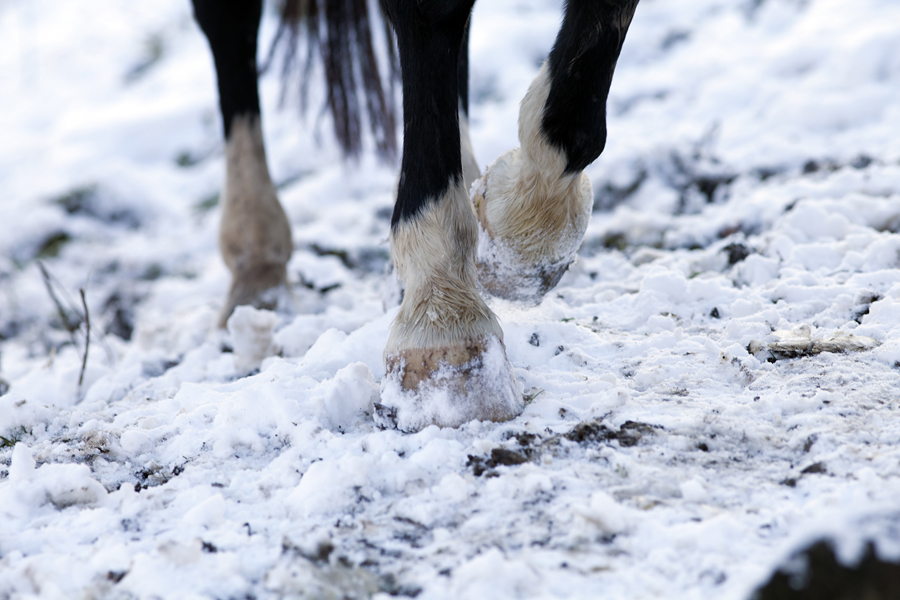The onset of winter often means changes in horsekeeping practices. These changes can have both positive and negative effects on your horse’s hoof quality – and on his overall health and well-being.
Winter is here, and with it comes snow, mud and cold. All these factors pose challenges to good winter hoof care and your horse’s general well-being. But even more challenging is the additional stall confinement many horses experience during inclement weather. Many barns and owners limit winter turnout because of ice, snow or cold temperatures, and that poses a different set of concerns for your horse’s feet and overall health.
Horses on the move
Horses accustomed to ample turnout do what they do best when outside — they graze and move freely over the paddock or pasture. If you were to count the number of steps your horse takes in an eight- or ten-hour day outside, it would probably surprise you. The bigger the area for turnout, the more steps he will take. Horses in the wild can cover many miles in a single day. Most domestic horses live in smaller areas and have planted pastures and supplied hay. But they will still follow their instincts and move around as freely as the area permits.
Once confined to a stall for hours at a time, however, this nomadic tendency is squelched and the horse is left to stand in one place for long periods. The potential effects of this immobility can be staggering. You may notice swelling in his legs. You may also notice that the natural wear you typically see on his hooves is not taking place. And too much stall time can cause other problems as well.
The stall-bound horse
Stalls that are not thoroughly cleaned generate additional hazards for a horse’s feet, as well as his overall health and well-being. Standing in damp bedding promotes thrush and abscess formation as well as other maladies. Bedding that contains manure or urine can take a toll on hoof wall integrity and lead to an invasion of bacteria into the hoof structures. There is little moisture available for the hooves when the horse is kept inside, so the hoof soaks up all the moisture it can – and if that moisture is in the form of urine, the result is surely less than optimal. Indoor arenas are also generally dry, so there is no help to be had there.
Meanwhile, those dark damp areas in barn corners become breeding grounds for worms. Lots of people don’t deworm frequently when their horses are inside because they think he won’t be outside gathering them. But in fact, they are growing close by.
Mental tolerance is another consideration in the stall-bound horse. Bored horses can be destructive. They can chew, rub, paw and roughhouse trying to escape. They may take to weaving or eating furnishings. They may crib and wind suck. Escape tactics can also be mastered when the motivation to relieve boredom is high.
Even if you often ride or routinely work with your horse during the winter, his constant desire to move and graze and roll is put on hold when poor weather takes away his outdoor play. This can result in your horse gaining weight, and not in a good way. His muscle tone and topline can suffer. He may develop more fat, but the lack of work will make him sluggish and he will sport less muscle. His metabolism will change and he may even be more prone to maladies like colic because his GI tract is not accustomed to so much time spent standing still. Think how you would feel if you were confined to a small powder room all day!
Beating the winter blues
So what is a horse owner to do? Ask for turnout! Take your horse for long snowy walks and rides – let him play and roll in the snow. Horses enjoy the cooler temperatures. We have all seen pictures of playful horses dodging and diving in the snow with the wind in their manes and tails. Horses rarely require the blankets we so love to adorn them with, and as we have talked about in other horses, blankets can actually make a horse feel colder. Your horse is built to be an all-weather machine. When we tamper, he loses some of his talents, natural defenses and abilities.
If you are searching for the perfect boarding facility, don’t forget to ask about winter turnout. If all else fails, snowy playtimes on a lead line are just what the doctor ordered for stall-bound horses. The more your horse can move and run and play during the winter, the better – not just for his feet, but for his overall health and happiness.
Winter trimming is necessary
You may have heard that hooves don’t grow as much in the winter so trims are not important. But remember that good hoof balance is always “in season”, so regular appointments with the farrier are still essential. Hoof growth is constant, and while the rate of growth varies from time to time for many reasons, they don’t just stop growing. The more the horse moves, the more his hooves will grow. Your farrier can also check for any signs of thrush or abscessing, and can detect any problems that may be developing from too much stall time.
Balanced barefoot trims also limit “snowballs” from building up in his feet and help your horse enjoy the wintertime as much as a good pair of boots helps you. The snow (and yes, even the winter mud) can provide essential moisture for the hoof and regular turnout where he can move freely is the best option.








